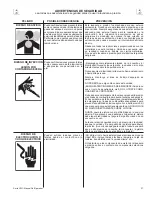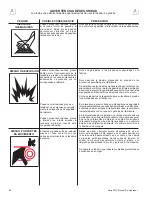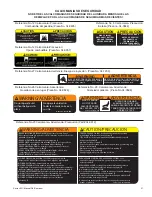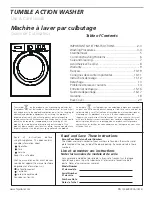
6
CWC-GASOLINE / DIESEL Operator's Manual
b
a
storaGe & Maintenance
sPecific Maintenance:
eVaPoratiVe eMission coMPonents:
The unit you have purchased includes the following components
that are in compliance with 2006 California Air Resources Board
Evaporative Emission Standards;
. Fuel Hose
2. Fuel Hose Fittings
These components should be inspected on a daily basis for cracks,
leaks, and abnormal wear. If cracking, leaks or abnormal wear has
occurred, the components should be replaced immediately.
enGine:
The engine instructions that accompany your unit detail specific
procedures for maintenance of the engine. Following the engine
manufacturer's recommendations will extend engine work life.
PuMP:
Change the pump oil after the first 50 hours of operation. After initial
change, every 3 months or 250 hour intervals are recommended.
If oil appears dirty or milky, changes may be required in greater
frequency. Use SAE20 or 30 Non-Detergent pump oil and fill only
to the center of the oil sight glass or the "Full" mark on the dipstick.
DO NOT OVERFILL.
QuicK couPlers:
There is an o-ring seal inside the female quick-coupler.
This o-ring will deteriorate or, if the unit is allowed to pump without
the high pressure hose attached, it may be blown out occasionally.
Simply insert a replacement o-ring to correct the leak. (Additional
o-rings can be purchased from your dealer.)
noZZles:
Water flow through the quick-connect spray nozzle will erode the
orifice, making it larger, resulting in a pressure loss. Nozzles should
be replaced whenever pressure is less than 85% of the maximum.
The frequency of replacement will depend upon such variables
as mineral content in the water and number of hours the nozzle is
used.
belt tension adJustMent:
To maintain peak performance of your pressure
washer, it may be necessary to adjust the belt tension on occasion.
Follow the procedure outlined below.
. Remove the belt guard and loosen the two nuts on each side
of the pump (Reference A). There are a total of 4 nuts.
2. Turn the cap screw (Reference B) clockwise until a /4 inch belt
deflection is noticed between the pulleys.
3. Tighten the side nuts (Reference A).
4. Put a straight edge across both pulleys. Pulley alignment is
critical for proper performance and service life. If necessary,
loosen one set of pulley screws and adjust in or out to properly
align. Tighten the pulley screws and check the tension again.
5. Replace the beltguard and tighten the fasteners securely.
belt tension adJustMent
















































